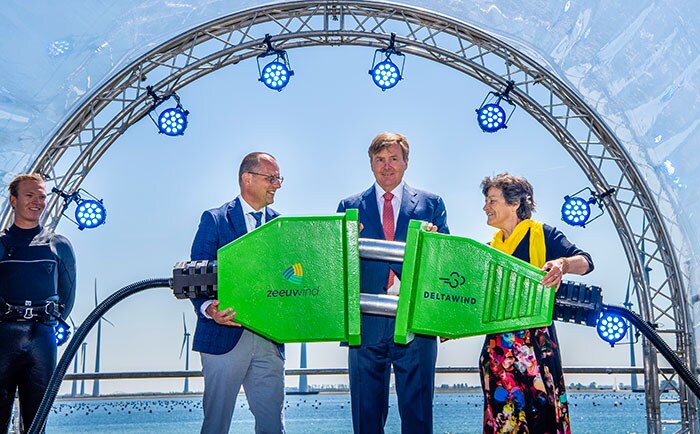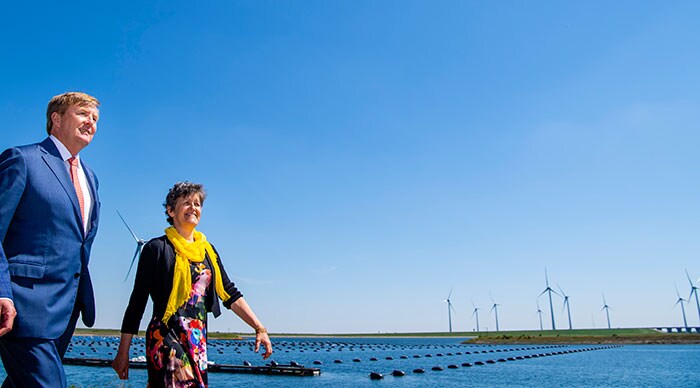May 16, 2019
Opening of new Dutch wind farm puts Philips on course to becoming carbon neutral by 2020
Amsterdam, the Netherlands – Following the opening of the Windpark Krammer in the southwest of the Netherlands in the presence of His Majesty King Willem-Alexander, Royal Philips (NYSE: PHG, AEX: PHIA), a global leader in health technology, achieved another major milestone on the road to becoming carbon neutral by 2020. Under the terms of a power purchase agreement (PPA) between the windfarm’s operators and the Dutch Wind Consortium – a joint initiative by Philips, DSM, Google and Nouryon (formerly AkzoNobel Specialty Chemicals) – the consortium partners will jointly purchase 95% of the wind park’s total 102 MW output (generated by 34 wind turbines) for the next 15 years. It means that 100% of Philips’ operations in the Netherlands will now be powered by renewable energy, matching the 100% renewable energy target already achieved in the company’s US operations. Globally it means that around half of Philips’ facilities worldwide will now be powered by green energy.
We see achieving carbon neutrality as soon as possible not only as a moral obligation but also as a business opportunity, because customers are increasingly looking at sustainability as a criterion to choose a vendor.
Frans van Houten
CEO Royal Philips
“Philips has a comprehensive sustainability strategy that is embedded into its business model both on the procurement side, such as the purchase of green energy, and on the customer side in the form of circular economy and sustainable healthcare solutions,” said Frans van Houten, CEO Royal Philips. “We see achieving carbon neutrality as soon as possible not only as a moral obligation but also as a business opportunity, because customers are increasingly looking at sustainability as a criterion to choose a vendor. It is also visible evidence of our commitment to meeting UN Sustainability Goal objectives, notably those on climate change, as part of our ‘Healthy people, Sustainable planet’ program.”
“Krammer has emerged from a unique citizens' initiative and Nouryon is proud to be one of their first customers,” said Marcel Galjee, Energy Director at Nouryon. “By working together in this green energy purchasing consortium with Philips, Google and DSM we aim to limit the risk in fluctuating energy supplies, while at the same time reducing emissions and growing our business.”
‘The opening of the Windpark Krammer is a milestone for the community, the Zeeuwind and Deltawind cooperations who initiated this project and for our consortium,” said Marc Oman, Google EU Energy lead. “It is because of long term purchase agreements with local windparks like Krammer that we can operate our business in the Netherlands in an environmentally sustainable way.”
Consumer to business, not business to consumer
The Dutch Wind Consortium is a unique initiative that attracted worldwide attention last year by jointly purchasing the energy output of Windpark Bouwdokken, another wind farm in the area that came on-stream in April 2018. The PPAs, negotiated with the wind farm operators in 2016 and 2017, represent win-win situations for all parties. The operators, in both cases part-owned by cooperatives comprising several thousand local Dutch citizens, are guaranteed a market for their energy, making it easier for them to finance green energy projects, while the consortium benefits from improved cost stability in volatile energy markets over a 15-year period. The consortium initiative will also help the Dutch government to achieve its 14% renewable energy target for 2020, as well as encouraging future commercial and citizen-driven green energy projects. The two windfarms have a combined capacity of more than 140 MW, enough to supply around 140,000 Dutch households with electricity.
Philips’ Healthy people, Sustainable planet program
Aligned with the United Nations Sustainable Development Goals, the Philips ‘Healthy people, Sustainable planet’ program has three focal areas: access to care for the underserved (SDG3), sustainable use of materials (circular economy and eco-design) (SDG12) and sustainable use of energy (energy and emission reduction, and renewable energy) (SDG13).
In addition to achieving the milestone of powering 100% of its Netherlands operations with renewable energy, other highlights of Philips’ SDG13 commitment include: an increase in its global renewable electricity share from 79% in 2017 to 90% in 2018; powering of all its US operations with renewable energy from the Los Mirasoles wind farm in Texas; and approval of its 2020 - 2040 CO2 emission targets by the Science Based Targets initiative (SBTi), a collaboration between the UN Global Compact, the World Resources Institute and the World Wide Fund for Nature aimed at driving ambitious corporate climate action.
Download a comprehensive case study on the Dutch Wind Consortium.
About Royal Philips
Royal Philips (NYSE: PHG, AEX: PHIA) is a leading health technology company focused on improving people's health and enabling better outcomes across the health continuum from healthy living and prevention, to diagnosis, treatment and home care. Philips leverages advanced technology and deep clinical and consumer insights to deliver integrated solutions. Headquartered in the Netherlands, the company is a leader in diagnostic imaging, image-guided therapy, patient monitoring and health informatics, as well as in consumer health and home care. Philips generated 2018 sales of EUR 18.1 billion and employs approximately 77,000 employees with sales and services in more than 100 countries. News about Philips can be found at www.philips.com/newscenter.












